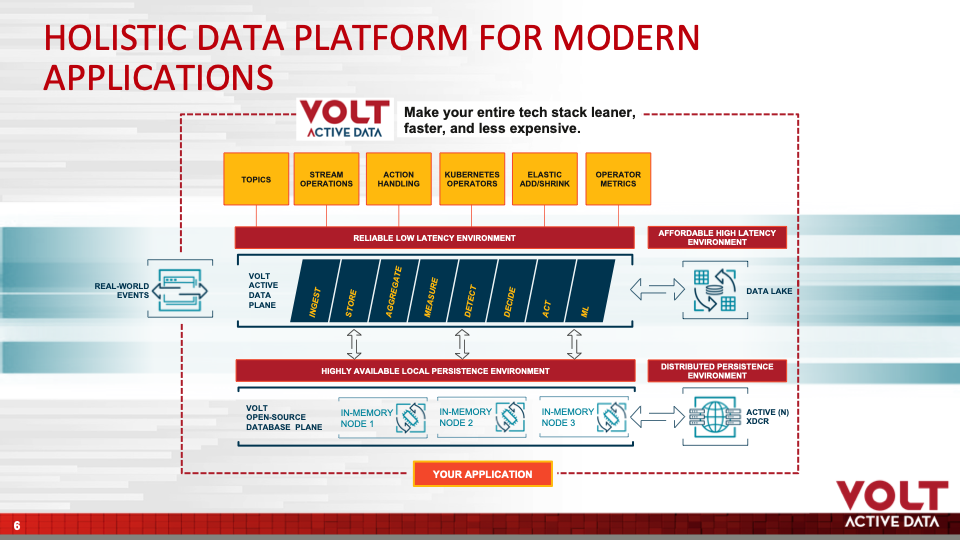The data world is changing faster than ever—but it’s always changing faster than ever. The speeds and volumes at which data now enters enterprise systems are of course far greater than even a year ago, and a year ago it was far greater than the year before, and so on and so on.
Now—with (relatively) new technologies such as 5G and edge computing upping the ante, so to speak, the data explosion is only getting bigger, faster, and well… more explosive.
Both 5G and edge computing have “very low latency “(ie, 1-2 milliseconds) in their core value propositions, and this is starting to cause serious issues for legacy tech stacks, which may, with enough added components, be able to react within a few milliseconds but can’t respond within that time-frame.
Why? And what’s the difference between “reacting” to data and “responding” to it?
Let’s dig in a little more.
Table Of Contents
Quick “Reactions” are Easy; Quick Responses? Not So Much
Almost any system has the ability to react quickly. A classic example is the ‘ping’ command, or a web server sending an image.
‘Reacting’ to data means responding to it in a stateless and predictable manner, without intelligence or context. When you ‘respond’, on the other hand, you take the new information you have, merge it with the other information you have, decide what to do, and then act in the most appropriate manner, based on all of this contextual wisdom. Fighter pilots actually use the same idea—and even apply the same language.
When you ‘respond’, you are (in theory), thinking several steps ahead, like a chess player. The problem, though, is that responding is inherently much more complicated because it typically involves multiple steps and often involves shared finite resources such as credits, bandwidth, or IP address allocations. This creates a problem: It’s really easy to react quickly if you don’t have to do any thinking; but once you realize that you need to respond and that coming up with a response is non-trivial, the limitations of a big, complicated, multi-layered stack suddenly become obvious. The problem isn’t that you can’t respond at all to the situation, it’s that, with a complicated stack, you can’t respond fast enough for it to matter, and all the investments you’ve made in all those extra parts for your stack will go to waste.
And that’s where having a simplified stack comes into play.
The Simplified Stack Imperative
With 5G and edge computing, you can’t simply react to data, you need to respond to it, but you also need to respond quickly enough to meet stringent 5G and edge latency SLAs. The challenge is that, over the last decade, two major trends have emerged that, while generally beneficial to building and deploying powerful and delightful applications, are now creating problems for the IT people in charge of making sure these applications stay “up”, stay personal, and don’t lag.
The first trend is tech stack complexity. The number of components in a solutions ‘stack’ has increased quite a bit as companies add new parts to handle the massive increase in (mainly 5G- and IoT-related) real-time data. This component proliferation is due in part to the number of mature open source projects now available and also due to hyperscalers producing ever-lengthening menus of ‘XYZ as a ‘service’. Thanks to both of the above, companies can now cobble together a solution much faster than they could before. However, the resulting stack usually has baked-in latency issues, as the layers need to communicate and even if the individual components are fast the net result isn’t. Volt has a number of customers who gave up trying to make such stacks work and came to us instead.
The second trend making life hard for people in charge of ensuring enterprise-grade applications run smoothly is the proliferation of microservices. While developers and architects love them, each time you split a component into two you create a new boundary, a new API, and a new set of possible failure modes, resulting in new and very challenging latency issues.
To address both of these issues, you need to rethink your tech stack architecture, which doesn’t necessarily mean rip and replace, but it does mean finding a way to simplify it.
How Volt Answers the ‘Respond vs React’ Question
Volt has a proven track record of responding to real-world events in single-digit milliseconds. Every day, more than one billion users and entities either directly or indirectly benefit from Volt technology in arenas ranging from mobile phone charging to fantasy sports platforms to industrial IoT device management.
At the heart of Volt’s ability to respond to real-time data is what we call the Volt Active Data Plane. While it uses the built-in, in-memory database capability of Volt, the Volt Active Data Plane allows responses that might involve 5 or 6 discrete steps to be produced in a single round trip to the Volt server.

The Volt Active Data Platform has at its core the “Volt Active Data Plane”, which was designed to enable enterprise-grade applications to go through the full data processing cycle—from ingestion to action—within two milliseconds.
In this way, the Volt Active Data Plane is a ‘one-hop shop’ that allows you to consolidate a whole series of functions and avoid latency-adding tech stack complexity. It allows you to ingest, store, aggregate, measure, decide, and act-on on real-time data in the course of one network event and hence within single-digit milliseconds, and it’s the only data platform capable of doing this.
Compare this to many if not most NoSQL solutions: the moment the data you’re working with can’t cleanly fit into a single Key/Value pair, it requires multiple network trips, changing data, and a whole host of latency-adding issues that will ultimately sink your application’s ability to stay future-proof.
Respond or React? It’s Your Call…
There’s somewhat of a fallacy happening right now in tech, which is this: “You can’t have it all.” You can’t have speed AND accuracy. You can’t have real-time reactions AND historical context. You can’t have 5G-enabled applications that also incorporate machine learning AND empower hyper-personalization.
People seem to think this because they’re not thinking about the foundational issues of their tech stack, because, rightfully so, they don’t even want to think about the headaches of doing a ‘rip and replace’ procedure; they’d rather just add on to what they already have (and, in doing so, add complexity and latency).
But…you won’t survive if you can’t respond to data, and you can’t (effectively) respond to data if you keep adding layers and complexity to your tech stack.
The nice thing about a technology such as Volt is that it doesn’t require a commitment to ripping and replacing or doing a total tech stack overhaul. It was built to provide a no-compromise solution turnkey, right off the bat, as a complement to your existing infrastructure, letting you start responding to real-time data from DAY ONE.
That’s the Volt promise.
You can get started with Volt here.


